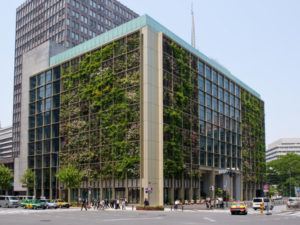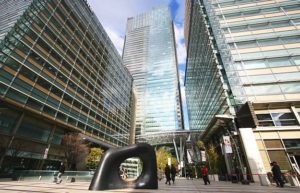Hello Tokyo: A Model Sustainable City
Tokyo: a model for sustainability!
Climate change, the buildup of greenhouse gases such as carbon dioxide which leads to change in global weather patterns, will pose a wide set of challenges for the world’s leading cities. Tokyo is no exception. The combination of Japan’s status as a net importer of both food and energy as well as Tokyo’s status as the largest city in the world make Tokyo particularly vulnerable to climate change. The Tokyo Metropolitan Government (TMG) has two unique motivations to shift towards sustainability. First, the 2011 Tsunami has had a strong impact on the psyche of the Japanese populace. Following the Tsunami, locals not only put a stronger emphasis on conserving energy, but also had a strong aversion to nuclear energy, which had previously been a significant source of energy for the country. Second, hosting the 2020 Summer Olympic Games has been a great stimulator of sustainable reform as Tokyo will be able to show its progress on world stage. This post will discuss some of the strategies the Tokyo Metropolitan Government (TMG) has employed to transform into one of the world’s most sustainable cities and how the TMG further promote sustainability within the global community.
In 2006 the TMG announced its goal to reduce greenhouse gas emission by 25% from the 2000 level by 2020. One of unique strategies the TMG employed was to rollout a green building program. Starting in 2002, all developers building projects with floor space over 10,000 were required to submit their floorplans to the TMG to be evaluated on four points: “appropriate utilization of resources”, “protection of natural environment”, “streamlining of energy use”, and “mitigation of the heat island phenomenon”. Through this four pronged regulatory system, the TMG has been able to incentivize builders to include sustainable elements in their building plans. One of the most notable behaviors that resulted from this regulation is the inclusion of greeneries (essentially vegetation within the building structure itself or parks/gardens within the plot of land being built on). Adding greeneries to large buildings has helped the city increase its natural ability to store rainwater and purify the air. Moreover, because the greeneries are so visually stunning, sustainability has been brought to the forefront of consumers’ minds in a very positive light!

Another innovative strategy the TMG launched is a Cap-and-Trade Program. The program launched in 2010, making it the world’s first mandatory reduction program for office buildings and commercial facilities. The program targets large facilities to maximize return on effort. To give a sense of size, the minimum energy consumption for buildings to qualify for the program is crude oil consumption of 1,500KL/year which translates to about 2,000-3,000 tons of CO2. Much like participants in international cap-and-trade programs, participants in the TMG program can achieve their mandatory level of CO2 reduction by either reducing themselves or by purchasing credits from other participants. Although the program must be implemented by building owners, tenants are the largest consumers of energy so building owners and tenants must work together to achieve CO2 reductions. This cooperation between developers and smaller business owners has helped the business community prioritize and promote sustainability.

The 2020 Olympics are a perfect platform for Tokyo to share its sustainable values with the global community. One of the interesting ways in which Tokyo is promoting sustainability during the Olympic Games is to link sustainability to Japanese culture. For example, in the official language about the Games, Tokyo is using the traditional Japanese concepts of taru wo shiru (what you have is all you need) and mottainai (concept of avoiding waste). Tying sustainability to learning about the culture of Japan is a great educational strategy because it contextualizes what to some can be a complex scientific concept and because it connects directly to one of the main goals of the Olympic Games – the sharing of culture.
Going forward, I would encourage the city of Tokyo to find more platforms to educate the world about its steps towards sustainability. More specifically, the TMG should show other governments how it has rolled out and benefited from its sustainable practices. As discussed in class, people (or governments) will naturally be reluctant to experiment until they see proven results. Given that Tokyo is an “extreme case” in terms of population and reliance on imported energy/food, if the TMG can move towards sustainability other governments can too! (751 words)



It’s interesting that it seems the incentives of building owners and tenants are aligned. If tenants don’t reduce carbon emissions, costs will be passed to them. I wonder if this is deliberate and I also wonder what the cost of all these proposed programs are.
I think Tokyo is a fascinating example of how local government can have an active/leadership role in shaping a city’s contribution to mitigating the impact of climate change. I think forcing down building regulation, like the need to include “green gardens” is something all local governments should be doing, but few have. I think the reason Tokyo is more successful in doing so is because it has the buy-in of its local citizens, likely because they themselves have experienced the devastating impact of climate change via extreme weather events like the tsunami. Its unfortunate to think that the experience of an extreme weather event would need to be a pre-requisite for local citizens and then local governments to begin legislating their communities with an eye towards environmental sustainability. I am excited to see how Japan leverages the 2020 Olympics as an opportunity to educate the rest of the world and what change will come from that.
Your viewpoint to link Tsunami and Tokyo Olympic to Tokyo’s motivation toward sustainability is unique and interesting. In fact, residents like me in areas which had been provided nuclear power needed to save energy so that we could avoid facing electricity shortage in (very humid) coming summer. I remember that both central and local governments utilized “earned” media effectively – every day we were warned by TV media about the potential electricity shortage, which generated strong public buy-in to sacrifice some convenience in daily lives to save energy. One aspect which would be interesting to keep eye on toward the Olympic is the leadership of current Tokyo mayor (Ms. Yuriko Koike). She is the person who led the most influential change in Japanese sustainability scene – “cool biz”, which allows office workers not to wear jacket / tie. Organizations which adopt cool biz policy set their air conditioner (AC) temperature at 82.4 F (or 28.0 C) to save energy. If Koike can reproduce her leadership success in the area of sustainability, as she did for cool biz 10 years ago, for the Olympic 2020, Tokyo could contribute to the rest of world by being “A Model Sustainable City” (your post title).
This is a very interesting post, and I think Tokyo is really doing a great job to demonstrate how could a city address the climate change challenge. Besides the reason of Tsunami that you mentioned, I also think as global warming causes sea level to rise, Tokyo, a coastal city, will face more challenges and thus should have greater motivation to transform into a sustainable city. I really like their ideas of green building and cap-and-trade program, and looking forward to seeing their proved success in the future years. The 2020 Olympic will be a great opportunity for this city to show its efforts to the world and share their best practices to help more cities transform into sustainable cities.
This is a really interesting article about how a city has approached being sustainable for the future. I’m wondering how the TMG has worked to reduce emissions from transportation as well as from buildings. This may be included in their cap-and-trade system, but how can they encourage more carpooling, use of public transportation, biking, and electric vehicles. Cities like Copenhagen have made it very expensive to own and use a car in the city, and tax very heavily on gas and emissions in order to incentivize the public to shift away from personal cars as a form of transportation. I also wonder how this can impact the suburbs and other parts of Japan.
The Tsunami of 2011 was absolutely devastating and horrible, and I do think it’s even sadder that it takes a horrendous event like that to make the world stand up and pay attention to the impact of climate change. It’s extremely encouraging to see that the TMG has been proactive to do its part to reduce the impact of climate change. I fear, however, that just one country’s direct impact will not be enough to stem the oncoming impact that’s already down the pipeline.
I wonder if the greatest impact that Japan’s actions will take will be the example that Japan and its government sets for the rest of the world. I think if Japan can demonstrate that its businesses thrive and its citizens don’t suffer any decline in quality of life, then other companies will be happy to follow Japan’s lead.
It was especially interesting to read this blog, because Tokyo has played an important role in climate change initiative. As we can learn from the name Tokyo protocol, or the efforts from Tokyo Metropolitan Government (TMG) to make the world’s most sustainable cities and how further promote sustainability within the global community. I learned a lot thank you!
Thank you for sharing this – I learned a lot!
I wonder if you have a perspective on any potential downsides to the “Tokyo as architect *and* beacon” role you hope the city will play in the 2020 Olympics. Specifically, there are a number of initiatives TMG has undertaken that are likely great examples for other cities to adapt to their own context, but is Tokyo’s experience and reaction to the use of nuclear energy a good thing for the rest of the world to focus on? In places where the risks are lower, shouldn’t some resources be devoted to promoting this efficient and cheap energy resource as a much better alternative to coal? I wonder how much the promotion during the Olympics will focus on avoiding nuclear energy versus emphasizing all of the other exciting initiatives.